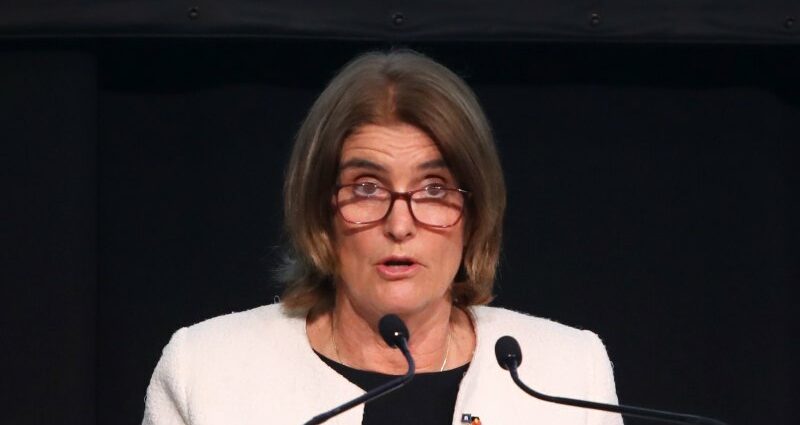Save articles for later
Add articles to your saved list and come back to them any time.
The money is once again on a Melbourne Cup rate rise from the Reserve Bank of Australia as the latest data points to an economy running much hotter than hoped.
As mortgage holders brace for another hit, questions will be rightly asked about whether there isn’t more the Albanese Government could be doing to rein in inflation.
RBA governor Michele Bullock and the board will meet on Tuesday to discuss interest rates.Credit: Bloomberg
On Tuesday, the RBA will consider the latest rounds of data on spending and employment. The latest read on inflation showed it running at 5.4 cent annually. Unemployment remains low at 3.6 per cent, while retail spending has ticked up by 2 per cent compared with the same time last year.
All of this paints a combined picture of an economy that is growing faster than necessary to bring inflation within the RBA’s target range of 2 to 3 per cent by the end of next year.
There are two options for slowing economic growth – higher interest rates or tighter fiscal policy. Whereas monetary policy like interest rate rises hits households with mortgages, it is a blunt tool. Fiscal policy, on the other hand, can be more nuanced and targeted in who it impacts.
Australia, we need to talk about tax.
To date, the federal government has played a role in slowing the economy, returning a $22.1 billion surplus in the last financial year. However, as it gets ready to deliver $254 billion in Stage 3 tax cuts next July, there should be real questions asked about how such largesse can be justified in the current economic climate.
The Stage 3 tax cuts put more money back into the pockets of middle and high-income households – that is, households with a lower need for income relief. The changes do this by removing the middle tax bracket of income taxation for those earning between $120,000 and $180,000, flattening the progressive income structure. They increase the top tax bracket to $200,000 and reduce the marginal tax rates for incomes between $45,000 and $200,000 to 30 per cent.
When they were announced back in 2019, the Stage 3 tax cuts were critiqued by economists who highlighted the folly in announcing such large reform so far out from their introduction. The Grattan Institute noted that it was unclear whether the tax cuts were affordable or the right size and shape for our economy, and that they would have the effect of crowding out meaningful tax reform into the future.
We now find ourselves in the position where the Stage 3 tax cuts stand to increase demand in the economy when the RBA is trying to lower it – acting directly against monetary policy and meaning households will face higher interest rates for longer. The changes will also add to structural issues within the budget, highlighted in the government’s own Intergenerational Report.
Prime Minister Anthony Albanese and Treasurer Jim Chalmers have said they will keep the Stage 3 tax cuts. Credit: Alex Ellinghausen
But rather than meaningfully addressing these issues, the government places itself in a position of prosecuting the case for tax changes that its own analysis does not support. And we find ourselves further away from any conversation about the structural tax settings needed to fund increasing levels of government provision.
We also know households are hanging on by a whisker. August 2023 polling from the ANU showed an uptick in the number of Australians who say they are finding it difficult to get by on their current income.
Because of their skew to middle and upper incomes, the Stage 3 tax changes will go mainly to male, high-income taxpayers. These effects go directly against the Albanese Government’s agenda to boost the economic equity of women.
Next month, the government will release its mid-year economic statement as a prelude to the May 2024 budget. It is the next significant piece in the Albanese Government’s legacy, following the Voice defeat in October that was a personal priority of the prime minister.
The government is only too aware that this moment represents an inflection point about its legitimacy and its agenda. It will set the course for the public’s understanding of the Albanese Government and what it exists to do.
There are real questions about social and economic equity that the government is making by proceeding with a stimulatory and regressive tax change.
It’s hard to see why a government that genuinely tries not to walk past social problems without trying to fix them feels so bound to hold the line on this. The Treasurer himself has said that the tax cuts will impose a growing cost on a budget already struggling under the weight of increasingly expensive programs. At what cost is it staying the course?
Dr Emily Millane is a partner at Impact Economics and Policy and a Senior Fellow at Melbourne Law School at the Centre for Commercial Law.
The Opinion newsletter is a weekly wrap of views that will challenge, champion and inform your own. Sign up here.
Most Viewed in Business
From our partners
Source: Read Full Article
-
Surprise Stimulus Check From Pennsylvania Hitting Bank Accounts Now
-
U.S. Retail Sales Growth Falls Short Of Estimates In April
-
German Consumer Sentiment To Improve In August: GfK
-
New Zealand Business Confidence Improves In May: ANZ
-
Lanxess Slips To Loss In Q4, Dividend Stable; Sees Flat EBITDA Pre Exceptionals In FY23



